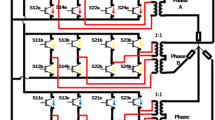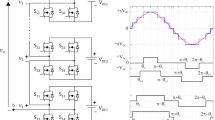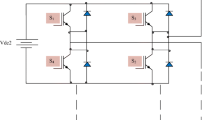Abstract
The escalating demand for sustainable and environmentally friendly energy sources has driven substantial growth in renewable energy adoption across residential and industrial sectors. To effectively meet this demand, the development of efficient and sustainable renewable energy conversion methods is crucial, with inverters playing a pivotal role in achieving this objective. While researchers strive to enhance inverter power handling capabilities and reduce output harmonic contents, the incorporation of additional power electronic switches and peripheral devices presents challenges such as increased circuit cost, complexity, and size. Additionally, the utilization of high-frequency switching techniques for achieving low output harmonics results in elevated switching losses and electromagnetic interference, adversely affecting sensitive electronic devices. This research introduces a novel approach to address these issues through the introduction of a reduced switch multilevel inverter topology. Unlike existing systems, the proposed topology employs a reduced number of power electronic switches and direct current sources to generate a stable output voltage waveform. Operating in a symmetric mode, the topology achieves a nine-level output voltage with enhanced harmonic elimination capabilities. A multiple-stepped selective harmonic elimination (SHE-PWM) switching control technique, employing a 1/3/3/1 distribution ratio, is utilized to extend the harmonic elimination range from 3 to 7 lower-order harmonics. To optimize the switching angles required for the proposed topology, the moth flame optimization (MFO) algorithm is employed and compared with particle swarm optimization (PSO) and whale optimization algorithms (WOA). The MFO algorithm exhibits faster convergence to the global optima, achieving an optimal fitness value of 3.322e−08 at 0.78 modulation points. This results in total harmonic distortion values of 0.7%, 0.757%, and 1.069% for MFO, PSO, and WOA, respectively, with corresponding total losses of 71.609W, 71.794W, and 79.792W. The proposed inverter topology is simulated using PSIM software and experimentally verified using a typhoon HIL-402 hardware-in-the-loop testing device. The simulation and experimental results provide compelling evidence for the superior performance of the MFO algorithm compared to PSO and WOA in achieving improved inverter performance. The proposed topology, in conjunction with the MFO algorithm, presents a promising solution for efficient and sustainable renewable energy conversion, thereby contributing to the advancement of renewable energy technologies in both residential and industrial settings.


































Similar content being viewed by others
Data availability
Data will be made available on reasonable request.
References
Demirbas MF, Balat M (2006) Recent advances on the production and utilization trends of bio-fuels: a global perspective. Energy Convers Manag 47(15–16):2371–2381
Kamal WA (1997) Improving energy efficiency the cost effective way to mitigate global warming. Energy Convers Manag 38(1):39–59
Strasser T (2015) A review of architectures and concepts for intelligence in future electric energy systems. IEEE Trans Ind Electron 62(4):2424–2438
Amjad AM, Salam Z (2014) A review of soft computing methods for harmonics elimination PWM for inverters in renewable energy conversion systems. Renew Sustain Energy Rev 33:141–153
AbuBakr S, Bahaj AS (2011) Generating electricity from the oceans. Renew Sustain Energy Rev 15(7):3399–3416
Yuksel I, Kaygusuz K (2011) Renewable energy sources for clean and sustainable energy policies in Turkey. Renew Sustain Energy Rev 15(8):4132–4144
Akhil G (2017) Influence of solar photovoltaic array on operation of grid-interactive fifteen-level modular multilevel converter with emphasis on power quality. Renew Sustain Energy Rev 76:1053–1065
Sridhar V, Umashankar S (2017) A comprehensive review on CHB MLI based PV inverter and feasibility study of CHB MLI based PV-STATCOM. Renew Sustain Energy Rev 78:138–156
Hasan NS, Rosmin N, Musta H (2016) Reviews on multilevel converter and modulation techniques. Renew Sustain Energy Rev 80(2016):163–174
Kaldellis JK, Kavadias KA, Koronakis PS (2007) Comparing wind and photovoltaic stand- alone power systems used for the electrification of remote consumers. Renew Sustain Energy Rev 11(1):57–77
Kouro S, Malinowski M (2010) Recent advances and industrial applications of multilevel converters. IEEE Trans Ind Electron 57(8):2553–2580
Mahalakshmi R, Thampatty K (2015) Grid connected multilevel inverter for renewable energy applications. Procedia Technol 21:636–642
Venkataramanaiah J, Suresh Y, Kumar A (2017) A review on symmetric, asymmetric, hybrid and single DC sources based multilevel inverter topologies. Renew Sustain Energy Rev 76:788–812
Etesami MH, Farokhnia N, Fathi SH (2015) Colonial competitive algorithm development toward harmonic minimization in multilevel inverters. IEEE Trans Ind Inform 11(2):459–466
Heidari YS, Jabbarvaziri F, Kumle AN (2015) Application of memetic algorithm for selective harmonic elimination in multi-level inverters. IET Power Electron 8(9):1733–1739
Kavousi A, Vahidi B, Salehi R, Bakhshizadeh M (2012) Application of the bee algorithm for selective harmonic elimination strategy in multilevel inverters. IEEE Trans Power Electron 27(4):1689–1696
Malinowski M, Gopakumar K, Rodriguez J, Perez MA (2010) A survey on cascaded multilevel inverters. IEEE Trans Ind Electron 57(7):2197–2206. https://doi.org/10.1109/TIE.2009.2030767
Rodriguez J, Lai J-S, Peng FZ (2002) Multilevel inverters: a survey of topologies, controls, and applications. IEEE Trans Ind Electron 49:724–738
Kumar M, Gupta R (2018) Time-domain characterisation of multicarrier-based digital SPWM of multilevel VSI. IET Power Electron 11(1):100–109
Pratheesh KJ, Jagadanand G, Ramchand R (2018) A generalized-switch- matrix-based space vector modulation technique using the nearest level modulation concept for neutral-point-clamped multilevel inverters. IEEE Trans Ind Electron 65(6):4542–4552
Sharifzadeh M, Vahedi H, Portillo R et al (2019) Selective harmonic mitigation based self-elimination of triplen harmonics for single-phase five-level inverters. IEEE Trans Power Electron 34(1):86–96
Srndovic M, Zhetessov A, Alizadeh T et al (2018) Simultaneous selective harmonic elimination and THD minimization for a single-phase multilevel inverter with staircase modulation. IEEE Trans Ind Appl 54:1532–1541
Son GT, Chung YH, Baek ST, et al. (2014) Improved PD-PWM for minimizing harmonics of multilevel converter using gradient optimization. In: IEEE PES general meeting 2014 conference exposition. National Harbor, MD, USA, pp 1–5
Tang T, Han J, Tan X (2006) Selective harmonic elimination for a cascade multilevel inverter. IEEE Int Symp Ind Electron 2:977–981
Wang H, Qi W (2021) A new Gauss–Newton-like method for nonlinear equations. Turk J Math 45:264–280
Ansary MT, Panda G (2020) A sequential quadratic programming method for constrained multi-objective optimization problems. J Appl Math Comput 64:379–397
Mercier Q, Poirion F, Jean-Antoine D (2018) A stochastic multiple gradient descent algorithm. Eur J Oper Res 271(3):808–817
Mirjalili S (2016) Moth-flame optimization algorithm: a novel nature-inspired heuristic paradigm. Knowl Based Syst 89:228–249
Ceylan O (2016) Harmonic elimination of multilevel inverters by moth-flame optimization algorithm. In: International symposium on industrial electronics (INDEL). IEEE, Banja Luka, Bosnia and Herzegovina, pp 1–5
Jangir N, Pandya MH, Trivedi IN, Bhesdadiya RH, Jangir P, Kumar A (2016) Moth-flame optimization algorithm for solving real challenging constrained engineering optimization problems. In: 2016 IEEE students’ conference on electrical, electronics and computer science (SCEECS). IEEE, Bhopal, India,pp 1–5
Etesami M, Ghasemi N, Vilathgamuwa DM et al (2017) Particle swarm optimisation-based modified SHE method for cascaded H-bridge multilevel inverters. IET Power Electron 10(1):18–28
Kar PK, Priyadarshi A, Karanki SB (2019) Selective harmonics elimination using whale optimisation algorithm for a single phase modified source switched multilevel inverter. IET Power Electron 12(8):1952–1963
Mirjalili S, Lewis A (2016) The whale optimization algorithm. Adv Eng Softw 95:51–67
Ab-Wahab N, Nefti-Meziani S, Atyabi A (2015) A comprehensive review of swarm optimization algorithms. PLoS ONE 10(5):1–36
Fister I et al (2013) A brief review of nature-inspired algorithms for optimization. Neural Evol Comput 80:1–7
Kar A (2016) Bio inspired computing—a review of algorithms and scope of applications. Expert Syst Appl 59:20–32
Ni J, Wu L, Fan X, Yang S (2016) Bioinspired intelligent algorithm and its applications for mobile robot control: a survey. Comput Intell Neurosci 2016:1–17
Yang X (2014) Swarm intelligence based algorithms: a critical analysis. Evol Intell 7(1):17–28
Filho F et al (2013) Adaptive selective harmonic minimization based on ANNs for cascade multilevel inverters with varying DC sources. IEEE Trans Ind Electron 60(5):1955–1962
Aggrawal H, Leon JI, Franquelo LG, Kouro S, Garg P, Rodriguez J (2011) Model predictive control based selective harmonic mitigation technique for multilevel cascaded H-bridge converters. In: Proceedings of 37th IEEE IECON. IEEE, Melbourne, VIC, Australia, pp 4424–4432
Ali M (2021) Robust ANN-based control of modified PUC-5 inverter for solar PV applications. IEEE Trans Ind Appl 57(4):3863–3876
Padmanaban S, Dhanamjayulu C, Khan B (2021) Artificial neural network and Newton Raphson (ANN–NR) algorithm based selective harmonic elimination in cascaded multilevel inverter for PV applications. IEEE Access 9:75058–75070
Alakkad M, Rasin Z, Rasheed M, Abd Halim W, Omar R (2020) Real-time switching thirteen-level modified CHB-Multilevel inverter using artificial neural network technique based on selective harmonic elimination. Indones J Electric Eng Comput Sci 20(3):1642–1652
Rasheed M, Alakkad M, Omar R, Sulaiman M, Abd Halim W (2020) Enhance the accuracy of control algorithm for multilevel inverter based on artificial neural network. Indones J Electric Eng Comput Sci 20(3):1148–1158
Lodi K et al (2020) Modulation with metaheuristic approach for cascaded-MPUC49 asymmetrical inverter with boosted output. IEEE Access 8:96867–96877
Hao J, Zhang G, Zheng Y, Hu W, Yang K (2019) Solution for selective harmonic elimination in asymmetric multilevel inverter based on stochastic configuration network and Levenberg–Marquardt algorithm. In: IEEE applied power electronics conference and exposition (APEC). IEEE, Anaheim, CA, USA, pp 2855–2858
Subramanyam G et al (2019) An improved artificial bee colony algorithm based harmonic control for multilevel inverter. J Control Eng Appl Inform 21:59–70
Chabni F, Taleb R, Helaimi M (2018) Optimum SHEPWM for a new 21-level inverter topology using numerical optimization methods: experimental comparative study. J Vib Control 24(23):5556–5569
Mohammadi H, Akhavan A (2014) A new adaptive selective harmonic elimination method for cascaded multilevel inverters using evolutionary methods. In: IEEE 23rd International symposium on industrial electronics (ISIE). IEEE, Istanbul, Turkey, pp 1484–1489
Ahmed MM, Saad M, Marizan M, Muhammad A (2018) Selective harmonic elimination in inverters using bio-inspired intelligent algorithms for renewable energy conversion applications: a review. Renew Sustain Energy Rev 82:2235–2253
De Leo´n-Aldaco SE, Calleja H, Alquicira JA (2015) Metaheuristic optimization methods applied to power converters: a review. IEEE Trans Power Electron 30(12):6791–6803
Dahidah MA, Agelidis VG (2008) Selective harmonic elimination PWM control for cascaded multilevel voltage source converters: a generalized formula. IEEE Trans Power Electron 23(4):1620–1630
Kotb KM, Hassan AW, Rashad EM (2017) Implementation of genetic algorithm-based SHE for a cascaded half-bridge multilevel inverter fed from PV modules. In: 20th International conference on electrical machines and systems (ICEMS). Sydney, NSW, Australia, pp 1–6
Taghizadeh H, Hagh MT (2010) Harmonic elimination of cascade multilevel inverters with non-equal dc sources using particle swarm optimization. IEEE Trans Ind Electron 57(11):3678–3684
Sundari MG, Rajaram M, Balaraman S (2016) Application of improved firefly algorithm for programmed PWM in multilevel inverter with adjustable dc sources. Appl Soft Comput 41:169–179
Patil SD, Kadwane SG, Gawande SP (2016) Ant colony optimization applied to selective harmonic elimination in multilevel inverters. In: Second international conference on applied and theoretical computing and communication technology (iCATccT), Bangalore, India, pp 637–640
Kundu S, Burman AD, Giri SK et al (2018) Comparative study between different optimisation techniques for finding precise switching angle for SHE-PWM of three-phase seven-level cascaded H-bridge inverter. IET Power Electron 11(3):600–609
Ceylan O (2021) Multi-verse optimization algorithm and salp swarm optimization. Neural Comput Appl 33:1935–1950
Shanono IH (2019) Selective harmonic elimination (SHE) based 3-phase multilevel voltage source inverter (VSI) for standalone applications. SN Appl Sci 1(1670):1–14
Shanono IH, Abdallah N, Daniyal H, Muhammad A (2020) Performance comparison of series and parallel damped LCL filters using 5-level voltage source converter. SN Appl Sci 1(471):1–12
Frank KD (2006) Effects of artificial night lighting on moths. In: Rich C, Longcore T (eds) Ecological consequences of artificial night lighting. Island press, Washington, pp 305–344
Gaston KJ, Bennie J, Davies TW, Hopkins J (2013) The ecological impacts of nighttime light pollution: a mechanistic appraisal. Biol Rev 88:912–927
Hof PR, Van Der Gucht E (2007) Structure of the cerebral cortex of the humpback whale, Megaptera novaeangliae (Cetacea, Mysticeti, Balaenopteridae). Anat Rec 290:1–31
Gambino G, Siano G, Palmieri G, Mauro W, Vanoli G, Criscuolo F, et al. (2014) A low-cost HIL platform for testing professional refrigerators controllers. In: Proceedings of the 19 th world congress the international federation of automatic control, vol 14. Elsevier Science Direct, Cape Town, South Africa, pp 3104–3109
Montazeri-Gh M, Nasiri M, Jafari S (2011) Real-time multi-rate HIL simulation platform for evaluation of a jet engine fuel controller. Simul Model Pract Theory 19(3):996–1006
Said SB, Saad KB, Benrejeb M (2017) HIL simulation approach for a multicellular converter controlled by sliding mode. Int J Hydrog Energy 42(17):12790–12796
Acknowledgements
The authors would like to acknowledge the financial support received from the University Malaysia Pahang and Ministry of Higher Education Malaysia under the Postgraduate Research Grant Scheme (PGRS) 200342 and (RDU) 200333.
Funding
The authors extend their appreciation to the Ministry of Education and University Malaysia Pahang for supporting the research.
Author information
Authors and Affiliations
Contributions
IHS and NRHA contributed to conceptualization; IHS provided methodology; IHS and AM provided software; HD and AMB performed validation; IHS performed writing—original draft preparation; IHS, NRHA, HD, and AM performed writing—review and editing; NRHA and HD performed supervision; AM carried out investigation; NRHA provided resources; IHS performed data curation; IHS and NRHA carried out formal analysis; HD and AM performed validation; NRHA contributed to funding acquisition. All authors have read and agreed to the published version of the manuscript.
Corresponding author
Ethics declarations
Conflict of interest
The authors declare that they have no conflict of interest.
Additional information
Publisher's Note
Springer Nature remains neutral with regard to jurisdictional claims in published maps and institutional affiliations.
Rights and permissions
Springer Nature or its licensor (e.g. a society or other partner) holds exclusive rights to this article under a publishing agreement with the author(s) or other rightsholder(s); author self-archiving of the accepted manuscript version of this article is solely governed by the terms of such publishing agreement and applicable law.
About this article
Cite this article
Shanono, I.H., Abdullah, N.R.H., Daniyal, H. et al. Moth flame algorithm-based optimization of a reduced switch multilevel inverter topology suitable for standalone application. Neural Comput & Applic 36, 9437–9479 (2024). https://doi.org/10.1007/s00521-024-09576-3
Received:
Accepted:
Published:
Issue Date:
DOI: https://doi.org/10.1007/s00521-024-09576-3




